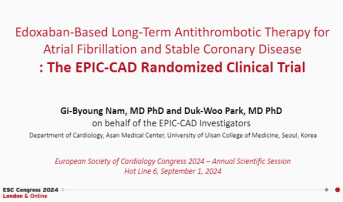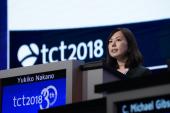Edoxaban Monotherapy Wins for AF and Stable Coronary Disease: EPIC-CAD
The results reinforce existing guidelines that advise pulling back on antithrombotic therapy in the chronic phase.

LONDON, England—For patients with high-risk atrial fibrillation (AF) and stable coronary artery disease, it makes sense to drop antiplatelet therapy and move forward with anticoagulation monotherapy, the randomized EPIC-CAD trial affirms.
The rate of net adverse clinical events (NACE) at 1 year was 6.8% among patients treated with edoxaban (Savaysa; Daiichi Sankyo) alone and 16.2% among those treated with edoxaban plus antiplatelet therapy (HR 0.44; 95% CI 0.30-0.65), co-principal investigator (co-PI) Gi-Byoung Nam, MD, PhD (Asan Medical Center, Seoul, South Korea), reported here at the European Society of Cardiology Congress 2024.
The difference was primarily due to a reduction in bleeding with monotherapy, with similar risks of ischemic events and mortality in the two arms of the trial, which was published simultaneously online in the New England Journal of Medicine.
AF is common in patients with CAD, and optimizing antithrombotic treatment in this setting can be tricky since the combination of oral anticoagulation and antiplatelet therapy markedly increases bleeding risks, Nam noted.
Based on multiple randomized trials, current guidelines contain strong recommendations for dual antithrombotic therapy with a direct oral anticoagulant (DOAC) and a P2Y12 inhibitor in the first 6 to 12 months after PCI or ACS in patients with an indication for oral anticoagulation. That initial period should be followed by anticoagulation monotherapy, although evidence supporting that advice is limited, Nam said.
Both OAC-ALONE and AFIRE suggested that anticoagulation monotherapy maintains protection against ischemic events and reduces bleeding compared with dual antithrombotic therapy, but they had limitations, he said.
In that context, EPIC-CAD “provides additional strong clinical evidence that would be applicable in future guidelines,” Duk-Woo Park, MD, PhD (Asan Medical Center), the other co-PI, told TCTMD. “If you have chronic coronary disease and atrial fibrillation, you can safely provide [oral anticoagulation] alone.”
The EPIC-CAD Trial
EPIC-CAD, conducted at 18 sites in South Korea, included 1,038 patients (mean age 72 years; 23% women) who had with high-risk AF (CHA2DS2-VASc score ≥ 2) and stable coronary disease. That was defined as: revascularization for a chronic coronary syndrome at least 6 months prior; revascularization for ACS at least 12 months prior; or anatomically confirmed coronary disease managed with medical therapy.
Investigators randomized patients to edoxaban at standard doses—60 mg once daily or a half dose for those meeting recommended dose-reduction criteria—plus aspirin or a P2Y12 inhibitor or to edoxaban monotherapy.
If you have chronic coronary disease and atrial fibrillation, you can safely provide [oral anticoagulation] alone. Duk-Woo Park
The primary NACE endpoint incorporated all-cause death, stroke, systemic embolism, MI, unplanned urgent revascularization, major bleeding, and clinically relevant nonmajor bleeding. The advantage for edoxaban monotherapy at 1 year—with a number needed to treat of 10.6—was consistent across various subgroups.
There were no significant differences between trial arms for the individual efficacy endpoints, including death and ischemic events, but edoxaban monotherapy reduced various bleeding endpoints:
- Major or clinically relevant nonmajor bleeding (4.7% vs 14.2%; HR 0.34; 95% CI 0.22-0.53)
- Major bleeding (1.3% vs 4.5%; HR 0.32; 95% CI 0.14-0.73)
- Clinically relevant nonmajor bleeding (3.5% vs 10.6%; HR 0.36; 95% CI 0.21-0.59)
- Any bleeding (9.9% vs 20.1%; HR 0.48; 95% CI 0.35-0.67)
There were no fatal bleeds in either group.
A Call to Follow the Guidelines
Discussing the results following Nam’s presentation, Marco Valgimigli, MD, PhD (Cardiocentro Ticino Institute, Ente Ospedaliero Cantonale, Lugano, Switzerland), noted that EPIC-CAD is now the fifth trial to provide insights into whether concomitant antiplatelet therapy is needed with oral anticoagulation in patients with AF and established coronary disease, joining OAC-ALONE, AFIRE, PRAEDO AF, and MASTER DAPT.
That last trial, for which Valgimigli was co-PI, examined the duration of dual antiplatelet therapy in post-PCI patients at high risk for bleeding, and about 36% were on oral anticoagulation. Researchers observed that when it was time to transition away from dual antithrombotic therapy in the trial and move forward with anticoagulation monotherapy, in either the experimental or control arm, many patients failed to do so, contrary to the strong recommendations in the guidelines.
I hope that the community will change, because in reality . . . the community was not convinced about the guidelines. Marco Valgimigli
Now, EPIC-CAD again demonstrates that dual therapy “is not the way to go,” Valgimigli told TCTMD.
He showed ESC attendees a meta-analysis of all five trials in this area, with a total of 5,785 patients, showing a relative 38% reduction in major bleeding and a 42% reduction in major or clinically relevant nonmajor bleeding—without increases in all-cause death, MI, stroke, or MACE—with anticoagulation monotherapy versus dual antithrombotic therapy.
“If you put these five studies together now, the message is very clear: there is an excess of bleeding complications and apparently no penalty with respect to ischemic events, or even more importantly, fatal events,” Valgimigli said. “The idea of combining treatment, it's probably not a good one. At a certain point, clinicians should stop doing the treatment combination and should embrace monotherapy [with anticoagulation].”
This doesn’t require a change to the guidelines, which “were already telling us to stop antiplatelet therapy at 6 or 12 months,” he stressed. “However, I hope that the community will change, because in reality . . . the community was not convinced about the guidelines. This study is actually reiterating the importance of that recommendation within the guidelines, which should hopefully now become more credible than it was before.”
One limitation of the accumulated evidence, Valgimigli said, is that four of the five studies were conducted solely in Asian populations, which have different bleeding and ischemic risks when compared with Western cohorts. “New studies are welcome,” he said, adding, however, that “I think now we have enough evidence to basically again reinforce the recommendation which has already been [put] forward by the guidelines before.”
He pointed out that there are other ongoing studies, including the MATRIX-2 comparing DOAC alone with dual antithrombotic therapy starting 30 days after stent implantation in patients with an indication for oral anticoagulation.
In the meantime, he told meeting attendees, irrespective of why a patient is on a dual antithrombotic regimen, “as a clinician, when you encounter such a patient, you should also ask yourself whether that regimen is or is not clinically justified.”
Todd Neale is the Associate News Editor for TCTMD and a Senior Medical Journalist. He got his start in journalism at …
Read Full BioSources
Cho MS, Kang D-Y, Ahn J-M, et al. Edoxaban antithrombotic therapy for atrial fibrillation and stable coronary artery disease. N Engl J Med. 2024;Epub ahead of print.
Disclosures
- The trial was funded by the CardioVascular Research Foundation (South Korea), Daiichi Sankyo, and Daewoong Pharma.
- Nam reports an institutional research grant/contract from Daiichi Sankyo.
- Park reports institutional research grants/contracts from the Cardiovascular Research Foundation, Daewoong Pharma, and Daiichi Sankyo.
- Valgimigli reports grants and/or personal fees from Abbott Vascular, Alvimedica/CID, AstraZeneca, Biotronik, Bristol Myers Squibb SA, Chiesi, Concept Medical, CoreFLOW, Daiichi Sankyo, Idorsia/Viatris Pharmaceuticals, Novartis, OM Pharma, Terumo, Universität Basel Department Klinische Forschung, and Vesalio.







Comments